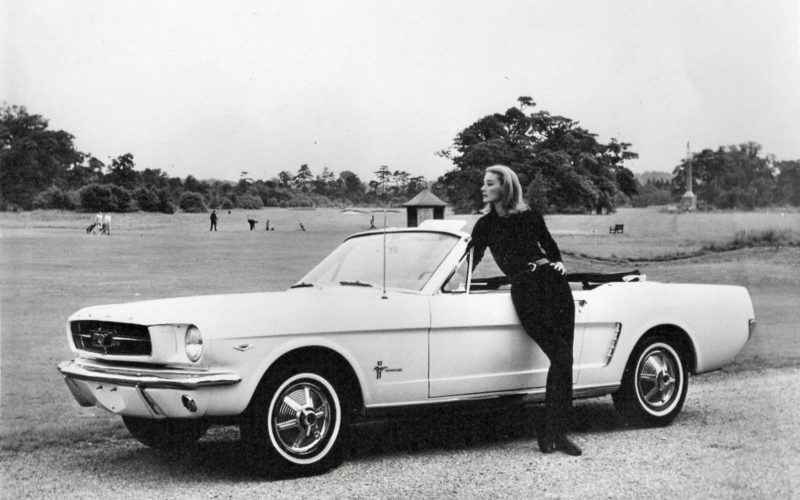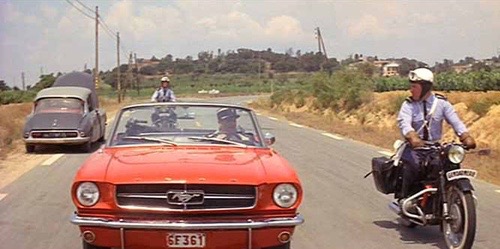Hey Boomer!
By 1960, the US was at the top. The country had emerged from the war unscathed 15 years earlier as a superpower, had a thriving economy, a bulging treasury and for a time produced more than half of the world's cars. The country was also extremely youthful: half of Americans were under the age of 20! No wonder that's where pop culture originated, around the jukebox, the burger joint and the drive-in cinema. And not much later, the 'baby boomers' would reach the age where an income, a home, a steady life partner and a family were within reach. And – on installment – also a car.
The market
Car factories do not make the cars they like, but for which there are enough customers who are willing to pay an x amount. Ford, like General Motors and Chrysler, built neat American family cars at the time that were tailored to the needs of the average car buyer: large, luxuriously decorated, spacious, comfortable. Under the hood a powerful gas guzzler. But not youthful or sporty. And not cheap enough to be bought and maintained by starters.
The Pony-Car
Lee Iacocca, the "human computer" Ford strategist who served as Secretary of Defense under Kennedy, saw through this opportunity. What he wanted was a car that looked sporty and youthful, with an adventurous image. Above all, it had to be very affordable, both in purchase and maintenance. Development costs also had to be limited, at Ford they had not forgotten the Edsel debacle. As an example, the Jaguar E-type was looked at: a long nose, a short stern, powerful, youthful, beautiful as a doe. Ford already built the Thunderbird. GM had the Corvette. But they were too expensive for the target audience. Those were horses. No ponies.
The Ford Mustang was developed in two years on the basis of the Ford Falcon, the cheapest Ford at the time. “Successful design” is an understatement: the end product was not only beautiful, it was trendsetting. Unlike the E-type, there were four seats, the rear seat was not very comfortable, but fine for children and therefore excellent for the target group. Finally, the young family man preferred not to take in-laws with him on long holiday trips.
In contrast to the Falcon, the Mustang did not have a front seat, but beautiful leatherette covered bucket seats. The dashboard was taken from the Falcon, complete with tire speedometer. That saved money. In the steering wheel hub, the text 'Falcon' was covered with a chrome trim that reads 'Mustang'.
In terms of motor, there was a choice of a 2800cc six-in-line and a 4300cc V8 – both to be linked to a four-speed or three-speed automatic – also technically the same as the Falcon. The advantage: the factory, distributors and dealers did not have to keep separate stocks of parts, everything was already there.
Actually, that first Mustang was a very simple car. But simplicity is beautiful. And simplicity is strength. The Falcon on which he based himself would be made almost unchanged in South America for more than 30 years. The simple technology made it reliable and the garage bill affordable.
Film debut
To promote the new 'Pony Car', he got a role in the latest James Bond film 'Goldfinger'. The first two Bond films were still purely British productions (and were not stiff with advertising) but for the third film American dollars, the knowledge and skills of MGM and the American director Guy Hamilton were called in. This was not only evident in the fact that the story was partly set in the US, but it was also evident in the sponsorship: all of the American cars in the film were donated by Ford (an entire Lincoln even went into the scrap press). ).
Shooting began in February 1964 in Switzerland, where Bond (with his legendary Aston Martin DB5) and Jill Masterson in her creamy white Ford Mustang convertible was filmed on the Furka Pass. Bond expertly drives her into the berm using a Ben Hur-esque villainy, severely damaging the Ford. That 'damage' consisted of trickery, because this Mustang was a unique example, hand-built in Dearborn, more than a month before series production started. There should be no scratch.
Yet 007 Goldfinger was not the premiere of the Mustang! The Ford factory in Genk had assembled a sample in March 1964 and made it available to Gerard Oury, for his film 'Le Gendarme de St. Tropez'. The pony car of the future, the sporty Ford was introduced to the general public by Louis de Funès, because De Gendarme hit the cinema a few weeks earlier than 007 / Goldfinger.
Presentation
The official press presentation took place at the Seattle World's Fair in June 1964, and from then on, the Rouge plant in Dearborn began spitting out millions of Mustangs. All Mustangs received the 1965 model year, but the first ones with the Falcon dashboard and hidden Falcon horn ring are called 1964 1/5 models and are sought after by collectors.
Unparalleled success
They were not to be dragged on. The Edseldrama could finally be laughed away by the Mustang. Instead of the expected sales of the cheapest versions to young people, the customers asked en masse for the most luxurious versions with the heaviest engines. These were soon replaced by heavier material. And because the Mustang could be used as an ordinary family car, the clientele was by no means limited to the youth. To meet the demand, Mustangs were soon assembled in Amsterdam, Cologne and Dagenham in addition to Genk.
Inspiration for the Capri and the Manta
The success continues to this day. The Mustang inspired Ford of Europe and General Motors Continental to come up with a similar concept of a sporty two-door design based on a regular family car in a variety of trims and engine variants. That led to the Ford Capri (1967) and the Opel Manta (1970). It was also the reason for other brands to make a completely different, exciting coupé or convertible based on their family box, such as the Triumph Spitfire (under the skin a Herald), the Simca 1000S (just like the Fiat 850 unrecognizable next to the base car) and the Renault Floride (actually a Dauphine).







Cool story again! thanks.
In the Louwman Museum, one of the two still existing DB's, I think, shows the scene of the “007 DB and the “Masterson Mustang” in Switzerland.
The charm of this scene can also be found here in the unreality.
Iacocca was short for I Am Chairman Of Chrysler Corporation America, they say…
Respect for Olav ten Broek's Mustang article. Most of the responses are also of a high standard.
Reason for me to be on Auto & Motor Klassiek to subscribe. In a sense, that means a return because the first editorial meetings of Het Automobiel were held at my home from 1980 onwards. Also later much written for Voiture's Courant. All ended up in the basket of AMK.
Thanks for the subscription, Pim. I hope you enjoy it.
Nice story of a great car!
Only the Triumph Spitfire, the Simca 1000s (coupé) and the Renault Floride were certainly there before the Mustang; 1962, 1961 and even 1958 for the Renault respectively. Would Ford then have copied the trick in Europe?
hello Olav
I'm always ready to catch anyone in the wrong, this time YOU: McNamara was a Managing Director under Henry Ford II, and was called off because he got a job as Secretary of Defense. But the Mustang was the child of Lee Iacocca who
was a design director.
Anyone who first saw a complete Lincoln Continental in the movie Goldfinger thrown into a scrap press, put the pressed remains on a Ford Ranchero Pickup and drove off again wondered if that was even possible.
The answer must be “no, that is certainly not possible”. The Falcon Ranchero had a payload of 363 kilos, a Lincoln Continental weighed 2.359 kilos and in the film it contained a million euros worth of gold, with a mass of 880 kilos.
Back home, poor Oddjob had to separate all that gold from the can again. Strange, he could have taken it out of the trunk before the Continental was pressed into tin cans. Anyway, you can write a book about the stupid mistakes in Goldfinger.
An absolute "PONYCAR" is forgotten, namely the rambler Marlin who gave the Ford men the idea to bring a car for the youth on the market. Study model Tarpon in 1963 and marketed in early 64 as MARLIN the predecessor of the MUSTANG by AMC the eternal "underdog" in the car world.
I'm glad you brought it up, because I didn't even think about it. Yes, AMC was the doomed underdog and didn't make it. Even though they also sponsored a James Bond film: Live and let die in 1973.
Nice article Olav!
I didn't even know the Mustang
Produced in Amsterdam(!)
Learned something again. They remain iconic cars. Impressive and painful, the realization that the young America of that time was an outgrowth of the war. Baby boomers, but also a generation of men who were cut out of society on a large scale by the war. Paradoxical that all this has led to something as beautiful as a Mustang.
The United States paid a toll of 418.500 human lives and, of course, an enormous number of warships and other equipment, but that was (certainly in proportion) limited compared to the, I will name 1 million Philippines, 3 million Japanese, 3,5 million Dutch Indians, 5,6 million Poles, 6 million Germans, 20 million Chinese and 27 million Soviets. In addition, US territory had been spared and their industry was more vital than ever before thanks to the war effort. In addition, the entire world was in debt to the US Treasury. A better economic position cannot be imagined. The party lasted until about 1973, the first oil crisis and the Japanese Invasion (not military but this time with small, economical and reliable cars).
Dear Olav, my respect for your almost inexhaustible automotive factual knowledge!
Oh no, I really have to do some research for such a piece. But I like that.
Nice car, design. However, the lower quality was due to the (too) low price. Restoration is easy to do, because it is not too expensive. Just give me GM.
As with most models, the first series is the most attractive and the most sought after.
You may wonder why car manufacturers always tend to modernize = mismaster their successful models when they have been on the market for several years.
I would also like such an early Mustang, solid, well maintained and sooo recognizable from the many films!
This is done to make the trade-in attractive. After a few years there is a new version in the showroom and suddenly your car has become "the old model". And a car - certainly in America - is not only a means of transport but also a status symbol, you show how successful you are. I must say that to this day Ford has always kept some styling cues from that first Mustang, such as the triple taillights.
Car manufacturers make good use of this.